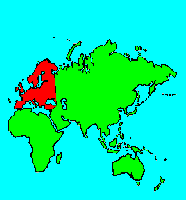SPECIES INFO
Ship sturgeon (Acipenser nudiventris) is found in rivers that drain into the Black Sea. This is also rarely found in rivers that drain into the Caspian Sea. This sturgeon reaches only 80 inches in length. Maitland notes that some examples have lived over 30 years and have spawned multiple times. This species is vulnerable, and yet might be in better condition than many of the other Eurasian species.Sturgeon genus (Acipenser) is found primarily in Eurasia with a representation of about 6 species in North America. Sturgeons are large bottom feeding fish with a forked tail. The upper tail lobe is much longer than the lower lobe. There are five rows on bony plates along the body. The small toothless mouth can extend to pick up bottom dwelling animals including mussels.
Sturgeons (Family Acipenseridae) are a group of worldwide freshwater bottom feeding fish. There are perhaps twenty-five species in this family. Sturgeons are known to have very long life spans and may live to over 150 years. Roe and Caviar are table names for sturgeon eggs. Because of over-fishing, many species of sturgeons have become quite scarce. Following is a list of some of the better known species of sturgeons:
Shortnose Sturgeon - Acipenser brevirostrum - Canada to Florida
Lake Sturgeon - Acipenser fulvescens - East United States
Green Sturgeon - Acipenser medirostis - Alaska-California
Atlantic Sturgeon - Acipenser oxyrhynchus - Canada - Louisiana
White Sturgeon - Acipenser transmontanus - Alaska-California
European Sturgeon - Acipenser sturio - Europe
Beluga - Huso huso - Black-Caspian Seas
Shovelnose Sturgeon - Scaphirhynchus platorynchus - Mid United States
Pallid Sturgeon - Scaphirhynchus albus - Missouri River
Sturgeon and paddlefish group (Order Chondrostei) contains the Bichirs, Sturgeons, and Paddlefish. Note that although this group is placed with the cartilage fish group, sturgeons do have bones. This small group of fish could be placed in several different taxonomic places (with the sharks or with the modern bony fish).
Sharks and rays (Elasmobranchi), cartilaginous fishes, deserve to be a class separate from the normal fish, in that they do not have a bone skeleton but rather a cartilage skeleton.
Fertilization is internal in this class which also separates them from the bony fish class. Although there are a few fresh water species, the majority of the species in this class are found in salt water. As of 2005, there were about 500 known species of sharks and about 600 known species of rays.
David Ebert, author of a recent book on sharks, rays, and chimaeras of California, counts a total of 988 described species in the class with about 150 additional species awaiting scientific description. He breaks down the described species to 410 species of sharks, 543 species of rays, and 35 species of chimaeras.
Many species of sharks face an uncertain future, as the Chinese purchase shark fins to make shark fin soup. It was estimated that 100 milllion sharks are killed each year for this purpose. However, recent estimates indicate the Chinese are reducing their consumption of this exotic soup.
Backboned Animals (Phylum Chordata) are the most advanced group of animals on earth. These animals are characterized by having a spinal cord or backbone. Most members have a clearly defined brain that controls the organism through a spinal cord. Fish, amphibians, reptiles, birds, and mammals are in this phylum.
Currently, some taxonomists believe that the fish should be divided into two groups (sharks and regular fishes) and that there are some other primitive groups in the phylum such as hagfish or lampreys.
Animal Kingdom contains numerous organisms that feed on other animals or plants. Included in the animal kingdom are the lower marine invertebrates such as sponges and corals, the jointed legged animals such as insects and spiders, and the backboned animals such as fish, amphibians, reptiles, birds, and mammals.

